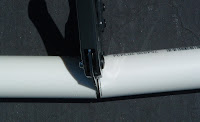.JPG)
Easier than I thought! The plans show you how to make the assembly from metal. The kit has the pieces made and they go together like love and marriage. A little pressure needed to push the spindle down over the wheel bolt in order to tighten or loosen onto the wheel.
.JPG) The steering arms (twisted pieces) have a larger hole that fits on the wheel axle. Don't forget to put the steering rod connector (little black piece with a hole in the end for the rod) on the inside of the bracket when inserting the long 8" bolt.
The steering arms (twisted pieces) have a larger hole that fits on the wheel axle. Don't forget to put the steering rod connector (little black piece with a hole in the end for the rod) on the inside of the bracket when inserting the long 8" bolt..JPG)
.JPG)


.JPG)

.JPG)


















